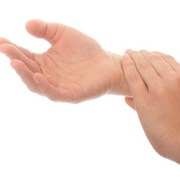 Zoonar/Thinkstock
Zoonar/Thinkstock
If you have ever noticed a bump under your skin around the wrist joint, it could be a ganglion cyst. According to WebMD, this is the most common location cysts occur. Ganglion cysts can also appear on the inside of the wrist, the fingertip, base of the fingers, the outside of the knee or ankle and on top of the foot.
Ganglion cysts are most common in women between the ages of 20 to 40. They have also been called “Bible cysts” from the old school treatment of smashing the cyst with a heavy bible to break it up. This therapy is no long recommended as it could cause further damage and does not keep the cyst from coming back.
One large ganglion cyst can develop under the skin or multiple smaller ones. The cysts look like a sacs filled with liquid about 1 to 3 cm in diameter that do not move. Inside there is a clear jelly-like material. The cysts may feel firm or spongy and can change size over time disappearing and reappearing for no particular reason.
Many ganglion cysts are painful though WebMD states that about one third do not have any symptoms except the appearance of the bump. The pain is usually described a being achy and is aggravated by joint motion. If the cyst is embedded in the tendon and if it puts pressure on nerves, numbness and weakness may be experienced.
It is unknown what causes ganglion cysts but people who perform activities that put more strain on their joints such gymnasts are more at risk for developing them.
Treatment:
A doctor needs to examine the area to confirm that the bump is a ganglion cyst. He may order X-rays, an ultrasound or an MRI to rule out other conditions. If the cyst is not bothering you, no treatment may be needed. The cyst may disappear on its own or come and go.
If treatment is desired, aspiration of the fluid from the cyst is performed by the doctor, which further confirms that it is a ganglion cyst. The fluid will be thick and clear. It is possible the doctor will want to give a steroid injection to the area afterwards.
According to Mayoclinic.com, up to 60 percent of ganglion cysts may recur. Additional aspirations may be performed or surgery may be suggested to actually remove the cyst. The surgery would be performed as an outpatient procedure and you probably will wear a splint for 7 to 10 days afterwards.
Sources:
Ganglion Cyst. WebMD. Retrieved Mar. 11, 2012.
http://www.webmd.com/a-to-z-guides/ganglion_cyst
Ganglion cysts By Mayo Clinic staff. Retrieved Mar. 11, 2012.
http://www.mayoclinic.com/health/ganglion-cysts/DS00767/METHOD=print
Ganglion Cyst. Retrieved Mar. 11, 2012.
https://www.empowher.com/media/reference/ganglion-cyst
Michele is an R.N. freelance writer with a special interest in woman’s healthcare and quality of care issues. Other articles by Michele are at www.helium.com/users/487540/show_articles
Edited by Jody Smith





Add a Comment1 Comments
I actually had surgery to relieve one, but after having another one recently am not sure I would do surgery. My cyst went away on its on, reoccurred once, then vanished for good. I think its fairly common for them to go away on their own. They can be a bit painful when pressure is applied.
March 14, 2012 - 4:58pmThis Comment